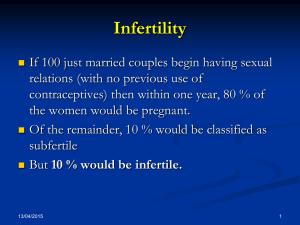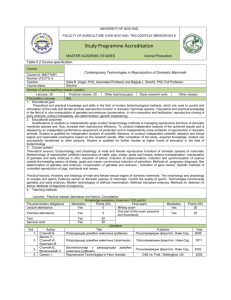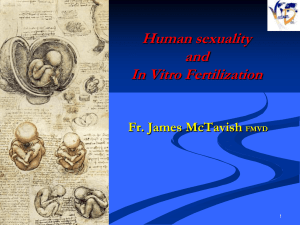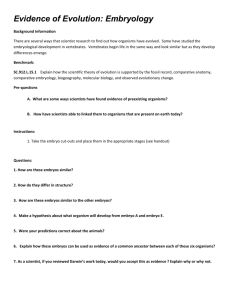A Pastoral Letter by Bishop Sean P. O`Malley, OFM Cap.
advertisement
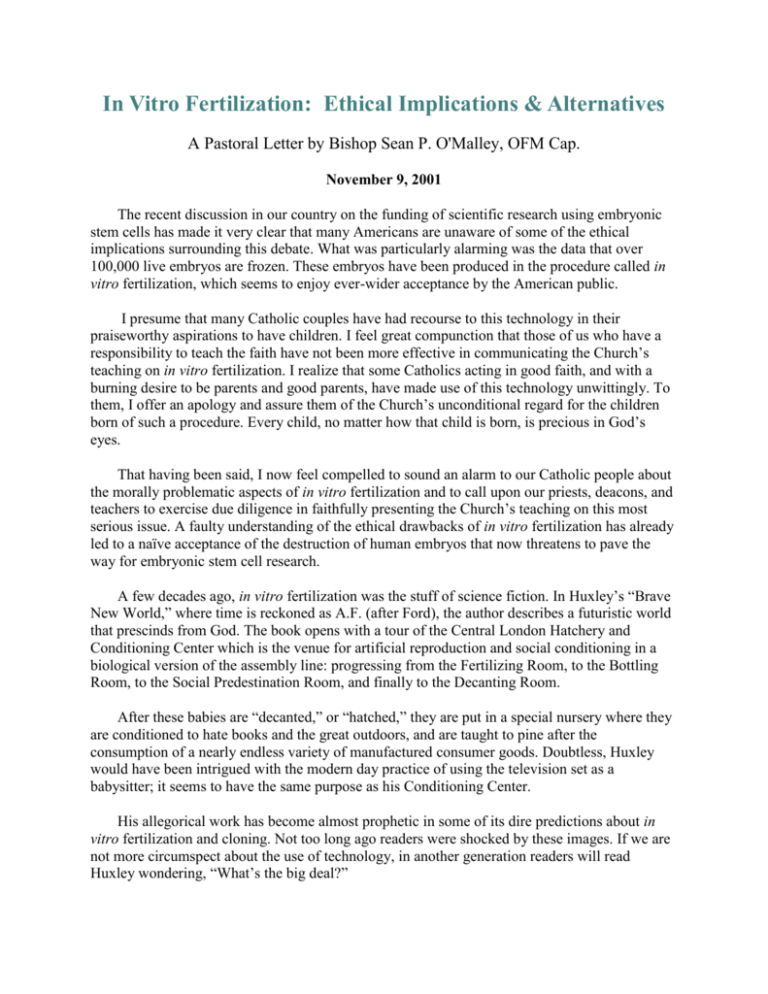
In Vitro Fertilization: Ethical Implications & Alternatives A Pastoral Letter by Bishop Sean P. O'Malley, OFM Cap. November 9, 2001 The recent discussion in our country on the funding of scientific research using embryonic stem cells has made it very clear that many Americans are unaware of some of the ethical implications surrounding this debate. What was particularly alarming was the data that over 100,000 live embryos are frozen. These embryos have been produced in the procedure called in vitro fertilization, which seems to enjoy ever-wider acceptance by the American public. I presume that many Catholic couples have had recourse to this technology in their praiseworthy aspirations to have children. I feel great compunction that those of us who have a responsibility to teach the faith have not been more effective in communicating the Church’s teaching on in vitro fertilization. I realize that some Catholics acting in good faith, and with a burning desire to be parents and good parents, have made use of this technology unwittingly. To them, I offer an apology and assure them of the Church’s unconditional regard for the children born of such a procedure. Every child, no matter how that child is born, is precious in God’s eyes. That having been said, I now feel compelled to sound an alarm to our Catholic people about the morally problematic aspects of in vitro fertilization and to call upon our priests, deacons, and teachers to exercise due diligence in faithfully presenting the Church’s teaching on this most serious issue. A faulty understanding of the ethical drawbacks of in vitro fertilization has already led to a naïve acceptance of the destruction of human embryos that now threatens to pave the way for embryonic stem cell research. A few decades ago, in vitro fertilization was the stuff of science fiction. In Huxley’s “Brave New World,” where time is reckoned as A.F. (after Ford), the author describes a futuristic world that prescinds from God. The book opens with a tour of the Central London Hatchery and Conditioning Center which is the venue for artificial reproduction and social conditioning in a biological version of the assembly line: progressing from the Fertilizing Room, to the Bottling Room, to the Social Predestination Room, and finally to the Decanting Room. After these babies are “decanted,” or “hatched,” they are put in a special nursery where they are conditioned to hate books and the great outdoors, and are taught to pine after the consumption of a nearly endless variety of manufactured consumer goods. Doubtless, Huxley would have been intrigued with the modern day practice of using the television set as a babysitter; it seems to have the same purpose as his Conditioning Center. His allegorical work has become almost prophetic in some of its dire predictions about in vitro fertilization and cloning. Not too long ago readers were shocked by these images. If we are not more circumspect about the use of technology, in another generation readers will read Huxley wondering, “What’s the big deal?” Stepping away from God’s law always introduces chaos into our lives. Nowhere is this truer than in the case of in vitro fertilization. The reproductive revolution has had the ability to separate genetic parenting from gestational parenting and from social parenting; and the agent who brings it all about, a biotechnician, will be still another person. In other words, we can arrange from the outset that one or more of the genetic parents are different from the woman who will carry the child, or the couple who will bring the child up. One or both of the donors might be deceased, for even the eggs might be extracted from aborted fetuses or a recently deceased woman. Sperm and eggs are being bought and sold and wombs are being rented. Typical prices for ova are $6,500, sperm $1,800 and surrogate motherhood $45,000. In California there is a Nobel Prize Winners’ sperm bank where someone can purchase “genius sperm” in the first step towards the “designer baby.” Anyone who has enough money can contract for the production of human beings according to the desired specifications. Scientists are already testing the embryos in the petri dish or in the womb to determine whether the child has desirable characteristics. One common reason for these tests is sex selection. Those Feminists who favor abortion should know that the embryos destroyed on this account are usually on the distaff side. The legal problems that arise from in vitro fertilization are legion. The number of persons who might assert parental rights is now expanded to five: the sperm donor, the egg donor, the surrogate womb mother, and the couple who raise the child. One wag has observed that the prospect of children with multiple parents is a marketing dream for the greeting card industry, and it is certainly a bonanza for lawyers. As problems of infertility and sterility become more common, people are turning to science for solutions. Modern science has developed various techniques such as artificial insemination and in vitro fertilization. In addition, there are also ancillary techniques designed to store semen, ova, and embryos. The fact that these techniques have been developed and have a certain success rate does not make them morally acceptable. The ends do not justify the means. In this case, the ends are very noble: helping an infertile couple to become parents. The Church, however, cannot accept the means. MARRIAGE: The Sanctity of Life The Catholic Church teaches that marriage is the only morally acceptable framework for human reproduction. Marriage and its indissoluble unity are the only venue worthy of truly responsible procreation. Accordingly, any conception engineered with semen or ova donated by a third party would be opposed to the exclusivity that is demanded of a married couple. Such a procedure would be a violation of the bond of conjugal fidelity. It is also an anomaly for a donor to contribute to the conception of a child with the express intention of having nothing to do with that child’s upbringing. Donation of semen or ova, and the use of surrogate motherhood to bear the child are both contrary to the unity of marriage and the dignity of the procreation of the human person. All of these procedures face a further difficulty in that they lend themselves to commercialization and exploitation when people are paid for donating their semen or ova, or for surrogate motherhood. The “Catechism of the Catholic Church,” quoting from the Vatican document Donum Vitae, (Instruction on respect for human life in its origin and on the dignity of procreation) asserts: “Techniques that entail the dissociation of husband and wife by the intrusion of a person other than the couple (donation of sperm or ovum, surrogate uterus) are gravely immoral. These techniques infringe on the child’s right to be born of a father and mother known to him, and bound to each other by marriage; moreover, these methods betray the spouses’ right to become a father and a mother only through each other” (#2376). Indeed, in the act of procreation the spouses are called to cooperate with God; therefore, the Church teaches that a child’s coming-tobe should be sought only as a fruit of the spouses’ personal loving union in the marital act. The “Catechism of the Catholic Church” also addresses those cases where the techniques employed to bring about the conception involve exclusively the married couple’s semen, ovum, and womb. Such techniques are “less reprehensible, yet remain morally unacceptable.” They dissociate procreation from the sexual act. The act which brings the child into existence is no longer an act by which two persons (husband and wife) give themselves to one another, but one that “entrusts the life and identity of the embryo into the power of the doctors and biologists, and establishes the domination of technology over the origin and destiny of the human person. Such a relationship of domination is in itself contrary to the dignity and equality that must be common to parents and children” (#2377). The Church has always taught that there is an “inseparable connection established by God between the unitive significance and the procreative significance which are both inherent to the marriage act” (Humanae Vitae12). In this sense in vitro fertilization, by doing away with the unitive meaning, is the mirror image of contraception which suppresses the procreative meaning of the conjugal act. God created man and woman in His own image and likeness and gave them the mission “to be fruitful and multiply.” This fruitfulness in marriage is part of their being made in the image of God. The marital act is one of mutual self-giving and mutual acceptance of two persons in love. It reflects the inner life of God in the Holy Trinity, a communion of love. Conjugal love is at the service of life and at the service of God, the Creator. Pope John Paul wrote in his “Letter to Families” that “in affirming that spouses as parents cooperate with God the Creator in conceiving and giving birth to a new human being…we wish to emphasize that God Himself is present in human fatherhood and motherhood. Indeed, God alone is the source of that ‘image and likeness’ which is proper to the human being, as it was received at Creation. Begetting is the continuation of Creation” (“Letter to Families” 9). SPARE EMBRYOS: Human Leftovers “I formed you in the womb, I knew you and before you were born, I consecrated you” (Jer 1:5). Pope John Paul II, commenting on this Scripture passage, writes: “the life of every individual, from its very beginning, is part of God’s plan...”(Evangelium Vitae #44). Expressions of awe and wonder at God’s intervention in the life of a child in its mother’s womb occur again and again in the Psalms and in the Gospel of St. Luke. In the light of God’s loving regard for life in the womb, the Holy Father raises the terrible question: “How can anyone think that even a single moment of this marvelous process of the unfolding of life could be separated from the wise and loving work of the Creator and left prey to human caprice?” (E.V. #44). Human life is precious from the moment of conception; but, sadly enough, the biblical respect for human life is being eroded in our contemporary society. Without a deep reverence for the sacredness of human life, humanity places itself on the path of self-destruction. When science and technology open doors that should not be opened, a Pandora’s box spews forth evils that menace humanity. We invented the atom bomb and germ warfare. These inventions are now part of human history forever. Scientists have opened another perilous door: they are manufacturing human life and using their product as an object of experimentation. Science without the compass of ethical restraints is taking us on a path towards dehumanization in the name of progress. Modern scientific advances have so much to offer, but they must be guided by ethical principles which respect the inherent dignity of every human being. When science embarks on a Promethean quest, fueled by greed and commercialization, our own humanity is placed at risk. The Vatican Document, Donum Vitae, expresses this well: “By defending man against the excesses of his own power, the Church of God reminds him of the reasons for his true nobility; only in this way can the possibility of living and loving with that dignity and liberty which derive from respect for the truth be ensured for the men and women of tomorrow” (Donum Vitae p. 39). Theoretically, it might be possible to use in vitro fertilization without destroying any embryos. The grave moral problems concerning the rights of the child, unity of marriage, and the integrity act would still militate against the morality of in vitro fertilization. However, typically, in in vitro fertilization a woman is given fertility drugs to ensure that she produces several ova which are collected to be fertilized in a petri dish creating several embryos. The healthiest ones are chosen for transfer to the woman’s womb. Many embryos are discarded or frozen. Freezing kills some more. Some embryos are later used for experimentation, which is always lethal. Recent estimates project that there are 100,000 frozen embryos in the United States laboratories. These embryos are human lives that, given the chance to grow, would develop into a man or a woman. The fate and disposition of these embryos represents a serious moral dilemma which has contributed to a coarsening of the public’s attitude towards the sacredness of human life. During recent debates before Congress, a couple gave compelling testimony against embryonic stem cell research. The main arguments that they presented were their two young sons who had been frozen embryos that the husband and his wife adopted. We cannot pretend that these embryos are tadpoles. They are human beings with their unique genetic code, full complement of chromosomes, and individual characteristics already in place. Every person alive today started out as an embryo. In vitro fertilization puts a great number of embryos at risk, or simply destroys them. These early-stage abortions are not morally acceptable. Unfortunately, many people of good will have no notion of what is at stake and simply focus on the baby that results from in vitro fertilization, not adverting to the fact that the procedure involves creating many embryos, most of which will never be born because they will be frozen or discarded. The Church’s teaching on the respect that must be accorded to human embryos has been constant and very clear. The Second Vatican Council reaffirms this teaching: “Life once conceived must be protected with the utmost care.” Likewise, the more recent “Charter of the Rights of the Family,” published by the Holy See reminds us that: “Human life must be absolutely respected and protected from the moment of conception.” Two corollaries of this principle follow very logically. First, pre-natal diagnosis and therapeutic procedures are licit and moral if they do not involve disproportionate risks and are directed toward healing or the survival of the embryo. Secondly, living embryos must never be used for experimentation which is not directly therapeutic to that human embryo. The Pro-Life Department of the United States Council of Catholic Bishops has published a question and answer document on respect for human embryos which explains: “No objective, even though noble in itself, such as a foreseeable advantage to science, to other human beings, or to society, can in any way justify experimentation on living embryos or fetuses, whether viable or not, either inside or outside the mother’s womb. The informed consent ordinarily required for clinical experimentation cannot be granted by the parents who may not freely dispose of the physical integrity or life of the unborn child.” This unequivocal teaching of the Church has important implications, not only regarding the morality of in vitro fertilization where so many embryos are sacrificed, but also in the area of embryonic stem cell research which requires the destruction of the living human embryo. Many scientists are anxious to employ “spare” embryos that result from the in vitro fertilization for research purposes. They point to the huge supply of frozen embryos that will eventually be discarded. As in the case of the production of clones for research purposes, the harvesting of the discarded embryos for research represents a conscious choice to use living human beings as mere research material. Sadly, some people would have pragmatism trump morality. It is encouraging that many states have legislation in place which protects the embryo and makes embryonic stem-cell research a felony. In the Commonwealth of Massachusetts the law forbids using embryos, “whether before or after expulsion from the mother’s womb, for scientific, laboratory research, or other kinds of experimentation” (M.G.L. Ch. 112 para. 12). The New York Times, on Aug. 26, 2001, reported that at fertility clinics the job that nobody wants is that of discarding the spare embryos. Most centers charge a yearly fee that ranges from a few hundred dollars to more than a thousand; but many embryologists do not discard embryos, even when clients cease to pay, “even if years go by”, the news article goes on to say. The director of one laboratory stated that he has to destroy the embryos himself because so many of his staff found the task distasteful. The embryos are thawed as though they will be used, just in case the patients change their minds. It is obvious that many of the medical staff involved in the in vitro fertilization process are aware of the grave responsibility they have for destroying human life. They have witnessed how these embryos have grown into healthy children. In discarding these embryos, the medical staff become their unwilling executioners, but executioners nonetheless. The Vatican document Donum Vitae clearly stated that the destruction of embryos harvested from in vitro fertilization procedures is tantamount to abortion. By voluntarily destroying human embryos, “The researcher usurps the place of God; and, even though he may be unaware of this, he sets himself up as the master of the destiny of others inasmuch as he arbitrarily chooses whom he will allow to live and whom he will send to death, and kills defenseless human being” (Donum Vitae, 1987). FROZEN EMBRYOS: Children on Hold During the already cited congressional hearings concerning stem-cell research, John Borden stood before the panel with both his sons in his arms and asked, “Which one of my children would you kill?” John and his wife, Lucinda, unable to have children of their own adopted frozen embryos that were “left over” from in vitro fertilization. Their striking testimony demonstrated that embryos are human beings in an early stage of development and therefore should not be sacrificed for embryonic stem-cell research. The action of this couple and many others raises the question, “What should be done with the frozen embryos?” Dr. Edward Furton of the National Catholic Bioethics Center published a fine article recently: “On the Disposition of Frozen Embryos.” The Church has not taken an official stand on what should be done. It is clear that in vitro fertilization is not an ethical practice. Nevertheless, the children born of this process are human beings, with the full rights and dignity of all members of the human family, and the frozen embryos produced are human and need to be respected as such. The most acceptable solution for the disposition of these embryos is that they be implanted in their mother’s womb and brought to term. This is the best option in a highly ambiguous situation since the embryos should not have been created in the first place. If the parents of the embryos are unable or unwilling to implant the embryo in the mother’s womb, what can be done with the frozen embryos? Moralists are beginning to debate this question. Theologians of the status of Dr. William May and Dr. Germain Grisey and Dr. John Furton, editor of Ethics & Medics of the National Catholic Bioethics Center, are of the opinion that it is preferable to place the frozen embryos up for adoption rather than to let them perish in a frozen gulag. Other moralists hesitate to countenance this approach because of the problem of surrogate motherhood. Nevertheless, we agonize over the predicament of these embryos. It is similar to the Church’s pastoral response to children born out of wedlock. While the Church cannot approve the circumstance of their birth since the children have already come into being, the Church must be concerned about their spiritual and material welfare. No one wants to encourage in vitro fertilization in any way; yet, there is a desire to rescue these innocent human beings that are in the words of Donum Vitae: “exposed to an absurd fate, with no possibility of their being offered safe means of survival that can be licitly pursued” (D.V. I.5). We are hopeful that in the near future the Holy See will offer some authoritative pronouncements on this very complicated issue. CHILDREN: A gift not an entitlement Professor Stanley M. Hauerwas, in his testimony on in vitro fertilization before the Ethics Advisory Board of the Department of Health, Education and Welfare, states: “Christians must surely be doubtful of any moral defenses of in vitro fertilization that claim this technique as an extension of freedom from natural necessity. From our perspective, such a claim involves the pretentious assumption that there is no limit to the right of people to perpetuate themselves.” Hauerwas’ assertion is certainly taught by the Church: We do not have a “right to have a child.” Such a right would be “contrary to the child’s dignity and nature. The child is not an object to which one has a right, nor can he be considered an object of ownership; rather, a child is a gift, ‘the supreme gift,’ and the most gratuitous gift of marriage, and is a living testimony of the mutual giving of his parents. For this reason the child has the right to be the fruit of the specific act of conjugal love of his parents; and the child also has the right to be respected as a person from the moment of his conception” (Donum Vitae, 8). One of the greatest absurdities of contemporary society is that our country has approved of people aborting all unwanted children and at the same time permits an immoral technique (in vitro fertilization) that allows a few women to have the experience of a pregnancy. In both of these circumstances the fate of the children is subordinated to the convenience or the personal aspirations of the parents. In the Old Testament, sterility was seen as a curse and a shameful condition. In part, immortality was understood as living on in your children and in their children. Childlessness then meant to be doomed to extinction and oblivion. The New Testament teaching on celibacy indicated to believers that not everyone needs to have children. It is a matter of vocation. The example of the consecrated virgins in the early Church testified to the importance of spiritual fruitfulness and gave witness of the Church’s firm belief in the Resurrection. Their lives, like the first martyrs, proclaimed to the world that in Christ we are all called to eternal life. It is therefore not necessary for everyone to have children to taste immortality. For us, marriage and motherhood and fatherhood is a vocation, and children are a gift. However, even when procreation is not possible, married life does not for that reason lose its value. As our Holy Father writes in Familiaris Consortio: “Physical sterility, in fact, can be for the spouses the occasion for other important services to the life of the human person; for example adoption, various forms of educational work, and assistance to other families, and to poor or handicapped children” (#14). All of us know childless couples whose goodness and generosity have been directed toward service of the parish, the community, and those in need. Often it is said of such a couple “what wonderful parents they would have been” because their marriage is so faith-filled and so loving. ADOPTION: A loving solution The plight of a couple who have difficulties in conceiving a child is something that concerns the Church community. We are pleased that the scientific community has developed some morally acceptable procedures that assist the conjugal act and not replace it: certain fertility drugs, micro-surgery, and treatments aimed at correcting defects in the reproductive organs, and Natural Family Planning techniques that allow couples to know when they have the best chance of conceiving. The Church does urge scientists “to continue their research with the aim of preventing the causes of sterility and of being able to remedy them so that infertile couples will be able to procreate in full respect for their own personal dignity and that of the child to be born” (D.V.8). Given the Biblical injunction to care for widows and orphans and to welcome strangers, the childless couple might in the spirit of our faith consider adopting a child. It is a decision that should be made after prayer and reflection. We have the example of so many wonderful couples who have taken on this commitment and made a loving family for children who lost their parents or whose parents were unable to raise them. One of the main factors contributing to the 1.5 million abortions in our nation every year is the poor attitude that Americans have toward giving up a child for adoption. Each year, around two million infertile couples try to adopt a baby in the United States, yet only about 50,000 adoptions take place. There are waiting lists for Down’s Syndrome and Spina Bifida babies and for infants with AIDS. Many couples go to Korea, Russia, Romania, Guatemala, China and other countries at great expense and make many sacrifices to adopt a baby. It is tragic that each year 1.5 million mothers in the United States opt for an abortion. Somehow they reach the point of making a decision to kill the child in their womb rather than allowing that child to live and to be adopted into a family that ardently desires to make a home for the fruit of an unwanted pregnancy. Even though a pregnancy might be unwanted, or illtimed, there should never be an unwanted baby. In fact, as the figures show there are enough families seeking to adopt babies so as to provide a home for all of the children aborted in our country. Those who embrace the Gospel of Life must be enthusiastic supporters of adoption. Some parishes have had special liturgies to celebrate the generosity and love of mothers who have put their child up for adoption, as well as for those families that have received those children lovingly as if they had been born into their family. This year in our own diocese, in order to underscore the importance of adoption in the Gospel of Life, we are having a diocesan Pro-Life celebration on the Feast of St. Joseph, the adoptive father of Jesus. The fact that in the Holy Family there was an adoptive father should be a source of encouragement to those who give their children in adoption and those who receive them. Other countries also experience the sad refusal of so many mothers to choose life by giving their children in adoption. Italy is witnessing a negative population growth that has given rise to serious concerns about the future of the Italian people. One parliamentarian has asked the government to support pregnant women by helping them to carry their baby to term so as to put the child up for adoption rather than let that child be lost to abortion. In our own diocese, and in dioceses throughout the nation, we have made the same offer of help. We stand ready to aid any woman with a difficult pregnancy who wishes to seek an alternative to abortion. We urge adopted children to help us promote adoption. Their mothers did not abandon them; but rather gave them life and the chance to live. The decision to entrust your child to another person is a difficult one, at times frightening; yet we are sure that it is the right decision. The Bible records the dispute of the two mothers before Solomon. The true mother is willing to give the child away rather than allow the king to kill the baby. When a mother lovingly entrusts her baby to an adoptive family, she has chosen life for her baby and will always be that child’s true mother, even as she shares that vocation with the adoptive parents. Pope John Paul II writes in Familiaris Consortio: “Christian families, recognizing with faith all human beings as children of the same Heavenly Father, will respond generously to the children of others, giving these children support and love, not as outsiders, but as members of the one family of God’s children. Christian parents will thus be able to spread their love beyond the bonds of flesh and blood, nourishing the links that are rooted in the Spirit…(F.C. 42). CONCLUSION In the rapidly changing culture of today, where everything is seen as experimental or obsolete, it must be growing clearer to believers that the Church’s commitment to the defense of innocent human life and the dignity of the human person is the firm centerpiece of our social Gospel. The very future of our society is contingent on the success of this enterprise: Life will be valued and protected or manipulated and destroyed. The culture of death can muster armies of celebrities to promote its positions. The media speaks with a roar, the Church in a whisper. The Church’s whisper, however, communicates a very consistent message that can never be silenced. The issue of in vitro fertilization is complicated. We all sympathize with childless couples who are desperate to have children, but the ends do not justify the means. There is much more at stake here than the public realizes. The Church’s teaching on in vitro fertilization is very clear and quite consistent with the Church’s teachings on marriage, on the dignity of the human person, and on the life ethic. A lack of knowledge about the ethical implications of this procedure has resulted in many couples having recourse to in vitro fertilization and has given further impetus to public support for embryonic stem-cell research. St. Paul once commented that people will not respond to an uncertain trumpet blast. I assure you there is nothing uncertain about the Church’s teaching on in vitro fertilization. We have only to turn up the volume of the trumpet.


